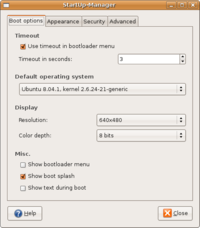GNU GRUB
GNU GRUB (GNU GRand Unified Bootloader) is a multi-boot loader, developed by the GNU project that allows us to choose which Operating System to boot from those installed.
It is mainly used on GNU/Linux operating systems. The Solaris operating system has used GRUB as the boot loader on x86 systems since the 10 1/06 revision.
History
GRUB was initially designed and implemented by programmer Erich Stefan Boleyn as part of work on booting the GNU Hurd operating system developed by the Free Software Foundation. In 1999, Gordon Matzigkeit and Yoshinori Okuji converted GRUB into a package of official software of the GNU Project and opened its development to the public.
Around 2002 Japanese researchers began work on PUPA (Preliminary Universal Programming Architecture), whose goal was to rewrite the GRUB body to make it clearer, safer, more robust, and more powerful. PUPA was later renamed GRUB 2, and the original version of GRUB was renamed GRUB Legacy. Since then, updates have been made to both versions. The last update to GRUB Legacy (version 0.97) was made in 2005.
Around 2007 some GNU/Linux distributions started using GRUB 2. By the end of 2009 most GNU/Linux distributions had GRUB 2 installed by default.
Features
GRUB is a boot loader that complies with the Multiboot Specification. This way you can uniformly boot kernels that conform to the Multiboot Specification.
It is designed to meet the following objectives, listed in order of importance:
- Basic functions have to be simple for end users.
- Wide functionality to support kernel experts and designers.
- Compatibility with previous versions to boot FreeBSD, NetBSD, OpenBSD and Linux. The compatible cores such as DOS, Windows NT and OS/2 are bootable using a chain load function.
Additional features supported:
- Recognize multiple executable formats.
- Supports kernels that do not meet multiboot specification.
- It supports configuration commands and can load a preset configuration.
- Provides menu interface.
- It has a flexible command line interface.
- It supports many file systems (BtrFS, ext2/ext3/ext4, FAT12/FAT16/FAT32, exFAT, HFS, HFS+” ISO9660, nilfs2, NTFS, ReiserFS, ZFS, ROMFS, JFS, XFS,...).
- Automatic decompression.
- Access to data located on any device installed.
- Independent of the geometry of the unit.
- It detects all the RAM installed.
- Supports logical block directioning (LBA).
- Network start.
- Remote terminals to allow control from a remote station.
GRUB Legacy Boot Process
- The BIOS searches for a starter device (such as the hard drive) and then passes control to the first physical sector of the device known as master boot record, are the first 512 bytes (first sector) of the hard drive and that form the phase 1 of GRUB.
- Phase 1 of GRUB loads the next phase of GRUB, physically located anywhere on the hard drive. Phase 1 can load either phase 1.5 or, directly, phase 2.
- Phase 1.5 of GRUB, located on the next 30 kilobytes of the hard drive, loads phase 2. In GRUB 2, this phase has ceased to exist.
- Phase 2 of GRUB (loaded by phases 1 or 1.5) receives control, and presents the start menu to the user.
- GRUB loads the kernel selected by the user, in memory and passes the control.
For EFI bootable computers, the firmware loads the GRUB executable directly (phase 2), as long as it is correctly installed on the EFI partition and configured in NVRAM.
GRUB 2

boot.img has exactly 446 Bytes and is written in the MBR (sector 0). core.img is written in the remaining space between the MBR and the first partition, if available (for reasons of compatibility with previous versions the first partition begins in sector 63 instead of sector 1, although it is not imposition). The /boot/grub- director may be located in another partition, or in the partition "/" ().GRUB 2 is a rewrite of GRUB that shares many features with its previous version, now known as GRUB Legacy. The most important differences between GRUB 2 and GRUB Legacy are:
- The GRUB 2 configuration file is ‘grub.cfg’ instead of ‘grub.conf’ or ‘menu.lst’. New syntax and many new commands are added. The file ‘grub.cfg’ is typically automatically generated by ‘grub2-mkconfig’ which greatly facilitates use.
- Partition numbers on the names of the GRUB devices now start at 1, instead of 0.
- A small amount of persistent storage is available between reboots, using ‘save_env’ and ‘load_env’ commands and ‘grub2-editenv’ utility. This is not available in all settings.
- GRUB 2 has more reliable ways to find its own files and target kernels in multiple disk systems, and has commands to search for devices using file system tags or unique universal identifiers (USAID).
- GRUB 2 supports many more file systems, including but not limited to Ext4, HFS+, and NTFS.
- GRUB 2 can read files directly from LVM and RAID devices.
- GRUB 2 has available a graphic terminal and a graphic menu system
- Image files that make up GRUB have been reorganized; stage 1, stage 1.5 and stage 2 no longer exist. Instead GRUB 2 has a variety of boot images (boot.img, diskboot.img, cdboot.img, pxeboot.img, lnxboot.img, kernel.img) to start GRUB in various ways, a kernel image (core.img) and a set of modules that are combined with the kernel image (*.mod).
- GRUB 2 introduces many installations in dynamically charged modules, allowing the kernel image to be smaller and built in more flexible forms.
Contenido relacionado
Regular phrase
I.Ae. 27 Pulqui I
IBM PC

